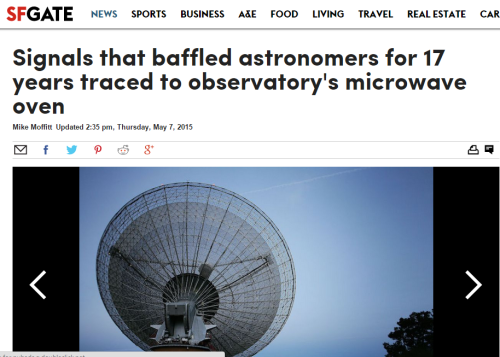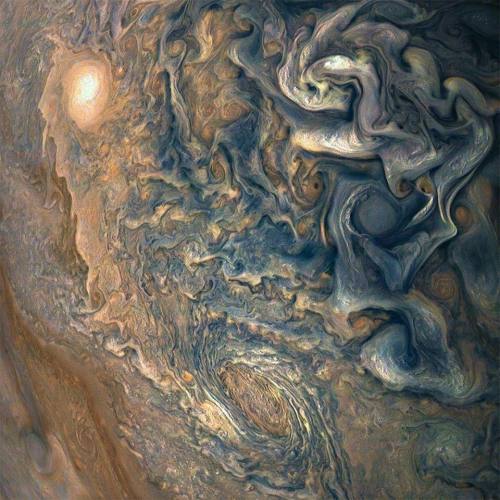Science-is-magical - Science Is Magic

More Posts from Science-is-magical and Others

whoa-o-o-o-o-oh-oh
WHOA-O-O-O-O-OH-OH
UPTOWN RAT
Blind people gesture (and why that’s kind of a big deal)
People who are blind from birth will gesture when they speak. I always like pointing out this fact when I teach classes on gesture, because it gives us an an interesting perspective on how we learn and use gestures. Until now I’ve mostly cited a 1998 paper from Jana Iverson and Susan Goldin-Meadow that analysed the gestures and speech of young blind people. Not only do blind people gesture, but the frequency and types of gestures they use does not appear to differ greatly from how sighted people gesture. If people learn gesture without ever seeing a gesture (and, most likely, never being shown), then there must be something about learning a language that means you get gestures as a bonus.
Blind people will even gesture when talking to other blind people, and sighted people will gesture when speaking on the phone - so we know that people don’t only gesture when they speak to someone who can see their gestures.
Earlier this year a new paper came out that adds to this story. Şeyda Özçalışkan, Ché Lucero and Susan Goldin-Meadow looked at the gestures of blind speakers of Turkish and English, to see if the *way* they gestured was different to sighted speakers of those languages. Some of the sighted speakers were blindfolded and others left able to see their conversation partner.
Turkish and English were chosen, because it has already been established that speakers of those languages consistently gesture differently when talking about videos of items moving. English speakers will be more likely to show the manner (e.g. ‘rolling’ or bouncing’) and trajectory (e.g. ‘left to right’, ‘downwards’) together in one gesture, and Turkish speakers will show these features as two separate gestures. This reflects the fact that English ‘roll down’ is one verbal clause, while in Turkish the equivalent would be yuvarlanarak iniyor, which translates as two verbs ‘rolling descending’.
Since we know that blind people do gesture, Özçalışkan’s team wanted to figure out if they gestured like other speakers of their language. Did the blind Turkish speakers separate the manner and trajectory of their gestures like their verbs? Did English speakers combine them? Of course, the standard methodology of showing videos wouldn’t work with blind participants, so the researchers built three dimensional models of events for people to feel before they discussed them.
The results showed that blind Turkish speakers gesture like their sighted counterparts, and the same for English speakers. All Turkish speakers gestured significantly differently from all English speakers, regardless of sightedness. This means that these particular gestural patterns are something that’s deeply linked to the grammatical properties of a language, and not something that we learn from looking at other speakers.
References
Jana M. Iverson & Susan Goldin-Meadow. 1998. Why people gesture when they speak. Nature, 396(6708), 228-228.
Şeyda Özçalışkan, Ché Lucero and Susan Goldin-Meadow. 2016. Is Seeing Gesture Necessary to Gesture Like a Native Speaker? Psychological Science 27(5) 737–747.
Asli Ozyurek & Sotaro Kita. 1999. Expressing manner and path in English and Turkish: Differences in speech, gesture, and conceptualization. In Twenty-first Annual Conference of the Cognitive Science Society (pp. 507-512). Erlbaum.

Drone with grabbing claw arms can lift 44 pounds
Prodrone’s latest creation could lift a four-year-old child, and uses its 5-axis metal claws to perch on fences like a bird.






Happy TRAPPIST-1 Day!
Here’s a comic on our latest discovery!
http://www.space.com/35806-trappist-1-facts.html
Galaxies: Types and morphology
A galaxy is a gravitationally bound system of stars, stellar remnants, interstellar gas, dust, and dark matter. Galaxies range in size from dwarfs with just a few hundred million (108) stars to giants with one hundred trillion (1014) stars, each orbiting its galaxy’s center of mass.

Galaxies come in three main types: ellipticals, spirals, and irregulars. A slightly more extensive description of galaxy types based on their appearance is given by the Hubble sequence.

Since the Hubble sequence is entirely based upon visual morphological type (shape), it may miss certain important characteristics of galaxies such as star formation rate in starburst galaxies and activity in the cores of active galaxies.
Ellipticals

The Hubble classification system rates elliptical galaxies on the basis of their ellipticity, ranging from E0, being nearly spherical, up to E7, which is highly elongated. These galaxies have an ellipsoidal profile, giving them an elliptical appearance regardless of the viewing angle. Their appearance shows little structure and they typically have relatively little interstellar matter. Consequently, these galaxies also have a low portion of open clusters and a reduced rate of new star formation. Instead they are dominated by generally older, more evolved stars that are orbiting the common center of gravity in random directions.
Spirals

Spiral galaxies resemble spiraling pinwheels. Though the stars and other visible material contained in such a galaxy lie mostly on a plane, the majority of mass in spiral galaxies exists in a roughly spherical halo of dark matter that extends beyond the visible component, as demonstrated by the universal rotation curve concept.
Spiral galaxies consist of a rotating disk of stars and interstellar medium, along with a central bulge of generally older stars. Extending outward from the bulge are relatively bright arms. In the Hubble classification scheme, spiral galaxies are listed as type S, followed by a letter (a, b, or c) that indicates the degree of tightness of the spiral arms and the size of the central bulge.
Barred spiral galaxy

A majority of spiral galaxies, including our own Milky Way galaxy, have a linear, bar-shaped band of stars that extends outward to either side of the core, then merges into the spiral arm structure. In the Hubble classification scheme, these are designated by an SB, followed by a lower-case letter (a, b or c) that indicates the form of the spiral arms (in the same manner as the categorization of normal spiral galaxies).
Ring galaxy

A ring galaxy is a galaxy with a circle-like appearance. Hoag’s Object, discovered by Art Hoag in 1950, is an example of a ring galaxy. The ring contains many massive, relatively young blue stars, which are extremely bright. The central region contains relatively little luminous matter. Some astronomers believe that ring galaxies are formed when a smaller galaxy passes through the center of a larger galaxy. Because most of a galaxy consists of empty space, this “collision” rarely results in any actual collisions between stars.
Lenticular galaxy

A lenticular galaxy (denoted S0) is a type of galaxy intermediate between an elliptical (denoted E) and a spiral galaxy in galaxy morphological classification schemes. They contain large-scale discs but they do not have large-scale spiral arms. Lenticular galaxies are disc galaxies that have used up or lost most of their interstellar matter and therefore have very little ongoing star formation. They may, however, retain significant dust in their disks.
Irregular galaxy

An irregular galaxy is a galaxy that does not have a distinct regular shape, unlike a spiral or an elliptical galaxy. Irregular galaxies do not fall into any of the regular classes of the Hubble sequence, and they are often chaotic in appearance, with neither a nuclear bulge nor any trace of spiral arm structure.
Dwarf galaxy

Despite the prominence of large elliptical and spiral galaxies, most galaxies in the Universe are dwarf galaxies. These galaxies are relatively small when compared with other galactic formations, being about one hundredth the size of the Milky Way, containing only a few billion stars. Ultra-compact dwarf galaxies have recently been discovered that are only 100 parsecs across.
Interacting

Interactions between galaxies are relatively frequent, and they can play an important role in galactic evolution. Near misses between galaxies result in warping distortions due to tidal interactions, and may cause some exchange of gas and dust. Collisions occur when two galaxies pass directly through each other and have sufficient relative momentum not to merge.
Starburst

Stars are created within galaxies from a reserve of cold gas that forms into giant molecular clouds. Some galaxies have been observed to form stars at an exceptional rate, which is known as a starburst. If they continue to do so, then they would consume their reserve of gas in a time span less than the lifespan of the galaxy. Hence starburst activity usually lasts for only about ten million years, a relatively brief period in the history of a galaxy.
Active galaxy
A portion of the observable galaxies are classified as active galaxies if the galaxy contains an active galactic nucleus (AGN). A significant portion of the total energy output from the galaxy is emitted by the active galactic nucleus, instead of the stars, dust and interstellar medium of the galaxy.

The standard model for an active galactic nucleus is based upon an accretion disc that forms around a supermassive black hole (SMBH) at the core region of the galaxy. The radiation from an active galactic nucleus results from the gravitational energy of matter as it falls toward the black hole from the disc. In about 10% of these galaxies, a diametrically opposed pair of energetic jets ejects particles from the galaxy core at velocities close to the speed of light. The mechanism for producing these jets is not well understood.

The main known types are: Seyfert galaxies, quasars, Blazars, LINERS and Radio galaxy.
source
images: NASA/ESA, Hubble (via wikipedia)

From vision to hand action
Our hands are highly developed grasping organs that are in continuous use. Long before we stir our first cup of coffee in the morning, our hands have executed a multitude of grasps. Directing a pen between our thumb and index finger over a piece of paper with absolute precision appears as easy as catching a ball or operating a doorknob. The neuroscientists Stefan Schaffelhofer and Hansjörg Scherberger of the German Primate Center (DPZ) have studied how the brain controls the different grasping movements. In their research with rhesus macaques, it was found that the three brain areas AIP, F5 and M1 that are responsible for planning and executing hand movements, perform different tasks within their neural network. The AIP area is mainly responsible for processing visual features of objects, such as their size and shape. This optical information is translated into motor commands in the F5 area. The M1 area is ultimately responsible for turning this motor commands into actions. The results of the study contribute to the development of neuroprosthetics that should help paralyzed patients to regain their hand functions (eLife, 2016).
The three brain areas AIP, F5 and M1 lay in the cerebral cortex and form a neural network responsible for translating visual properties of an object into a corresponding hand movement. Until now, the details of how this “visuomotor transformation” are performed have been unclear. During the course of his PhD thesis at the German Primate Center, neuroscientist Stefan Schaffelhofer intensively studied the neural mechanisms that control grasping movements. “We wanted to find out how and where visual information about grasped objects, for example their shape or size, and motor characteristics of the hand, like the strength and type of a grip, are processed in the different grasp-related areas of the brain”, says Schaffelhofer.
For this, two rhesus macaques were trained to repeatedly grasp 50 different objects. At the same time, the activity of hundreds of nerve cells was measured with so-called microelectrode arrays. In order to compare the applied grip types with the neural signals, the monkeys wore an electromagnetic data glove that recorded all the finger and hand movements. The experimental setup was designed to individually observe the phases of the visuomotor transformation in the brain, namely the processing of visual object properties, the motion planning and execution. For this, the scientists developed a delayed grasping task. In order for the monkey to see the object, it was briefly lit before the start of the grasping movement. The subsequent movement took place in the dark with a short delay. In this way, visual and motor signals of neurons could be examined separately.
The results show that the AIP area is primarily responsible for the processing of visual object features. “The neurons mainly respond to the three-dimensional shape of different objects”, says Stefan Schaffelhofer. “Due to the different activity of the neurons, we could precisely distinguish as to whether the monkeys had seen a sphere, cube or cylinder. Even abstract object shapes could be differentiated based on the observed cell activity.”
In contrast to AIP, area F5 and M1 did not represent object geometries, but the corresponding hand configurations used to grasp the objects. The information of F5 and M1 neurons indicated a strong resemblance to the hand movements recorded with the data glove. “In our study we were able to show where and how visual properties of objects are converted into corresponding movement commands”, says Stefan Schaffelhofer. “In this process, the F5 area plays a central role in visuomotor transformation. Its neurons receive direct visual object information from AIP and can translate the signals into motor plans that are then executed in M1. Thus, area F5 has contact to both, the visual and motor part of the brain.”
Knowledge of how to control grasp movements is essential for the development of neuronal hand prosthetics. “In paraplegic patients, the connection between the brain and limbs is no longer functional. Neural interfaces can replace this functionality”, says Hansjörg Scherberger, head of the Neurobiology Laboratory at the DPZ. “They can read the motor signals in the brain and use them for prosthetic control. In order to program these interfaces properly, it is crucial to know how and where our brain controls the grasping movements”. The findings of this study will facilitate to new neuroprosthetic applications that can selectively process the areas’ individual information in order to improve their usability and accuracy.
The Neuroscience of Drumming

According to new neuroscience research, rhythm is rooted in innate functions of the brain, mind, and consciousness. As human beings, we are innately rhythmic. Our relationship with rhythm begins in the womb. At twenty two days, a single (human embryo) cell jolts to life. This first beat awakens nearby cells and incredibly they all begin to beat in perfect unison. These beating cells divide and become our heart. This desire to beat in unison seemingly fuels our entire lives. Studies show that, regardless of musical training, we are innately able to perceive and recall elements of beat and rhythm.
It makes sense then that beat and rhythm are an important aspect in music therapy. Our brains are hard-wired to be able to entrain to a beat. Entrainment occurs when two or more frequencies come into step or in phase with each other. If you are walking down a street and you hear a song, you instinctively begin to step in sync to the beat of the song. This is actually an important area of current music therapy research. Our brain enables our motor system to naturally entrain to a rhythmic beat, allowing music therapists to target rehabilitating movements. Rhythm is a powerful gateway to well-being.
Neurologic Drum Therapy
Neuroscience research has demonstrated the therapeutic effects of rhythmic drumming. The reason rhythm is such a powerful tool is that it permeates the entire brain. Vision for example is in one part of the brain, speech another, but drumming accesses the whole brain. The sound of drumming generates dynamic neuronal connections in all parts of the brain even where there is significant damage or impairment such as in Attention Deficit Disorder (ADD). According to Michael Thaut, director of Colorado State University’s Center for Biomedical Research in Music, “Rhythmic cues can help retrain the brain after a stroke or other neurological impairment, as with Parkinson’s patients ….” The more connections that can be made within the brain, the more integrated our experiences become.
Studies indicate that drumming produces deeper self-awareness by inducing synchronous brain activity. The physical transmission of rhythmic energy to the brain synchronizes the two cerebral hemispheres. When the logical left hemisphere and the intuitive right hemisphere begin to pulsate in harmony, the inner guidance of intuitive knowing can then flow unimpeded into conscious awareness. The ability to access unconscious information through symbols and imagery facilitates psychological integration and a reintegration of self.
In his book, Shamanism: The Neural Ecology of Consciousness and Healing, Michael Winkelman reports that drumming also synchronizes the frontal and lower areas of the brain, integrating nonverbal information from lower brain structures into the frontal cortex, producing “feelings of insight, understanding, integration, certainty, conviction, and truth, which surpass ordinary understandings and tend to persist long after the experience, often providing foundational insights for religious and cultural traditions.”
It requires abstract thinking and the interconnection between symbols, concepts, and emotions to process unconscious information. The human adaptation to translate an inner experience into meaningful narrative is uniquely exploited by drumming. Rhythmic drumming targets memory, perception, and the complex emotions associated with symbols and concepts: the principal functions humans rely on to formulate belief. Because of this exploit, the result of the synchronous brain activity in humans is the spontaneous generation of meaningful information which is imprinted into memory. Drumming is an effective method for integrating subjective experience into both physical space and the cultural group.
-
 hellsiteaffectionate reblogged this · 2 months ago
hellsiteaffectionate reblogged this · 2 months ago -
 neokalpa liked this · 3 months ago
neokalpa liked this · 3 months ago -
 annita89slyzpqlkh liked this · 7 months ago
annita89slyzpqlkh liked this · 7 months ago -
 just-a-normal-freak reblogged this · 1 year ago
just-a-normal-freak reblogged this · 1 year ago -
 cantchangemypast reblogged this · 1 year ago
cantchangemypast reblogged this · 1 year ago -
 whisperinglunabug liked this · 1 year ago
whisperinglunabug liked this · 1 year ago -
 rifundentrestde liked this · 1 year ago
rifundentrestde liked this · 1 year ago -
 kupdetiwar liked this · 1 year ago
kupdetiwar liked this · 1 year ago -
 zanyeggangelcalzone liked this · 1 year ago
zanyeggangelcalzone liked this · 1 year ago -
 se-hace-camino liked this · 2 years ago
se-hace-camino liked this · 2 years ago -
 floricane liked this · 2 years ago
floricane liked this · 2 years ago -
 helloweese reblogged this · 2 years ago
helloweese reblogged this · 2 years ago -
 mintceres reblogged this · 2 years ago
mintceres reblogged this · 2 years ago -
 ilovebooks17 reblogged this · 2 years ago
ilovebooks17 reblogged this · 2 years ago -
 ilovebooks17 liked this · 2 years ago
ilovebooks17 liked this · 2 years ago -
 driftinginburgerland reblogged this · 2 years ago
driftinginburgerland reblogged this · 2 years ago -
 paradise-runway reblogged this · 2 years ago
paradise-runway reblogged this · 2 years ago -
 accidental-gravitas reblogged this · 2 years ago
accidental-gravitas reblogged this · 2 years ago -
 meredithshayne reblogged this · 2 years ago
meredithshayne reblogged this · 2 years ago -
 jrocci reblogged this · 2 years ago
jrocci reblogged this · 2 years ago -
 heart4buddie reblogged this · 2 years ago
heart4buddie reblogged this · 2 years ago -
 thefruitthatgodforgot liked this · 2 years ago
thefruitthatgodforgot liked this · 2 years ago -
 paradise-runway reblogged this · 2 years ago
paradise-runway reblogged this · 2 years ago -
 lupi-lobster reblogged this · 2 years ago
lupi-lobster reblogged this · 2 years ago -
 tothemoon-inaminute liked this · 2 years ago
tothemoon-inaminute liked this · 2 years ago -
 thecutepuppyone reblogged this · 2 years ago
thecutepuppyone reblogged this · 2 years ago -
 ludakris0 reblogged this · 2 years ago
ludakris0 reblogged this · 2 years ago -
 klunkyboots reblogged this · 2 years ago
klunkyboots reblogged this · 2 years ago -
 cairdes reblogged this · 2 years ago
cairdes reblogged this · 2 years ago -
 nicijones reblogged this · 2 years ago
nicijones reblogged this · 2 years ago -
 nicijones liked this · 2 years ago
nicijones liked this · 2 years ago -
 amethysthollis reblogged this · 2 years ago
amethysthollis reblogged this · 2 years ago

















